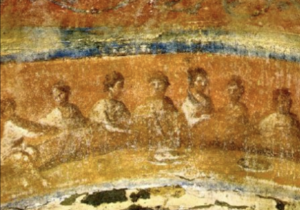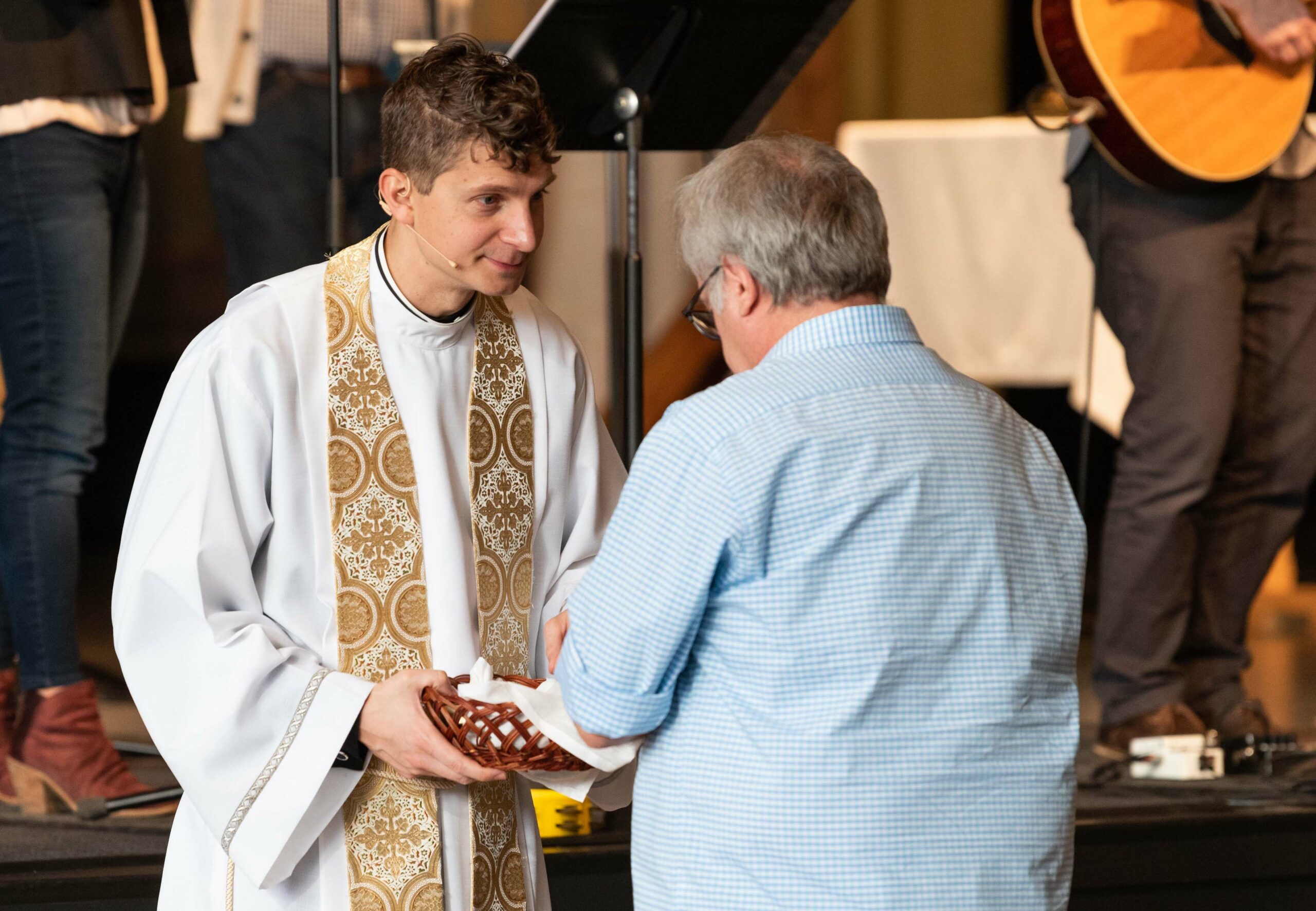By Blake Adams
The common cup—when an assembly drinks consecrated wine together from a single vessel—was the norm in every Christian tradition until the last decade of the nineteenth century. Why the change? For starters, it was not precipitated by any development in eucharistic theology. In fact, it didn’t seem to have mattered what a tradition’s sacramentology happened to be up to the 1890s: transubstantiationalist, memorialists—all used the common cup.¹
Instead, the single contributing factor was a growing popular awareness of germ theory, stimulated by an outbreak of tuberculosis. It isn’t known which tradition switched first, but by the first decade of the twentieth century, individual cups were promoted by clergy from multiple traditions. The arguments, always the same, were pragmatic: individual cups were more sanitary and convenient.² The most we can say about the modern origin of individual cups is that they are American, Protestant, just over a century old, and caught on quickly.
The only other time that the Church used individual cups was in the earliest decades of her existence. The eucharistic celebrations described in Paul’s letters were full-blown meals resembling the formal banquets of the ancient Mediterranean world.³ Individual cups would have been used, but there was nothing especially symbolic about them: they were the convention for all banquets—Greek, Roman, or Jewish. This begs the question: Why did the common cup eventually replace individual cups and become the standard practice for almost two millennia?
The story of this switch begins in the oldest surviving discussion of a Christian assembly, Paul’s disappointed first letter to the Church of Corinth. In ancient times, whatever was used in worship had to be supplied by the members. In Corinth the wealthier individuals ate and drank (to excess) but did not share what they brought with the poorer Christians who could bring nothing. The Church of Corinth was not a common assembly that shared in a common worship (cf. Acts 4:32–35; also Matt. 25:31–46; Prov. 22:2; Rev. 13:16). Paul believed disunion among the assembly undermined their corporate union in Christ, leading him to conclude harshly, “it is not the Lord’s supper that you eat” (1 Cor. 11:20). Despite gathering together, they had failed to “discern the body” (1 Cor. 11:29), by which Paul meant not so much the body of Christ identified with the bread, but the Body (the Church) thus constituted by those who shared the bread.
Paul analogizes the oneness of the elements with the oneness of the assembly:
“The cup of blessing which we bless, is it not a communion in the blood of Christ? The bread which we break, is it not a communion in the body of Christ? Because there is one bread, we who are many are one body, for we all partake of the one bread” (1 Cor. 10:16–17).
Both of these, the Eucharist and the Church, are signs of Christ’s mystical presence in the world. In the elements of the Eucharist, we enjoy our communion as the Body of Christ (the Church) by partaking of the body of Christ (the sacrament). But only an assembly that is one can partake of one bread. Ingesting this Pauline teaching, early Christians writers agreed on what the Eucharist accomplished: its primary effect is the “gathering up” of the individual members of the Church into the common life of Christ. 4

Perhaps the earliest mention of the common cup is found in the letters of Ignatius, the bishop of Antioch, which he wrote on the road while being escorted by guards to be martyred in Rome sometime before A.D. 117. Ignatius discerned that heresy, not so much persecution, can divide the communion of saints as much as Corinthian drunkenness. Against schismatics, Ignatius wrote: “Take care, therefore, to participate in one Eucharist, for there is one flesh of our Lord Jesus Christ, and one cup that leads to unity through his blood.” In Ignatius’s writings, for the first time, both bread and cup were each “one.” He then emphasized these are found on “one altar” under “one bishop.”5 For Ignatius, the cup was one because the Church was one. Around this time, the earliest artistic representation of a eucharistic liturgy was painted: Fractio Panis (“Breaking of Bread”), a Greek fresco in a Roman catacomb. It depicts the common cup.
The (re-)emergence of individual cups is owed to the new hygienic concerns of modern America. It could be argued that the common cup was a pragmatic development: it guaranteed that all present could partake; it moderated intake, preventing drunkenness; it required less expense than traditional banquets; and it meant less clean-up. But when we consult the early writers on the topic, we find they do not speak of pragmatics, but of a theological symbolism deeply responsive to the Pauline emphasis on corporate unity. Nowhere is the vision of our union in Christ more stark than when all members of the Church, rich and poor, male and female, Greek and Jew, slave and free (cf. Gal. 3:28–29), gather to drink from the same cup. In that moment, the divisions, deceits, and empty promises of the world turn translucent. We see one another openly as brother and sister sharing a common portion at our Father’s table.
The common cup is not essential for the Eucharist, and not all must partake of it (indeed, some should not, such as those with certain medical conditions). But symbols speak. We should prefer a symbol as we prefer a word. The question then is not which symbols are required for the effectivity of the sacrament, but which support us as worshipers—which “say” what we really think we are doing as we are doing it, and what we think it means when we are told to “feed on him in your hearts by faith, with thanksgiving” (“The Ministration of Communion,” BCP 2019).
Read Blake’s follow-up article, “How Hygienic Is Common Cup“
—–
¹ The only resistance to the wide adoption of individual cups was a strain of biblicism in some Protestant groups: see James F. White, Protestant Worship: Traditions in Transition (Louisville, KY: Westminster John Knox Press, 1989), 175. This biblicism was unaware of the conventions of ancient Mediterranean banquets, however, including the Passover. It is most likely that each attendee of the Last Supper, the biblicist’s model for the Lord’s Supper, would have had his own cup, though Jesus refers only to the royal “this cup,” in the singular.
² A representative example of an endorsement for individual cups from this period survives in an article by the Lutheran Rev. J. D. Krout, “The Individual Communion Cup,” United Brethren Review 17.2 (March–April 1906): 101–05.
³ See Andrew B. McGowan, Ancient Christian Worship: Early Church Practices in Social, Historical, and Theological Perspective (Grand Rapids, MI: Baker Academic, 2014), ch. 2.
4 E.g., Didache, 9.4, in The Apostolic Fathers in English, ed. and trans. Michael W. Holmes, 3rd ed. (Grand Rapids, MI: Baker Academic, 2006), 168; Hippolytus of Rome, On the Apostolic Tradition, trans. Alistair C. Stewart, Popular Patristics Series 54, 2nd ed. (Yonkers, NY: St Vladimir’s Seminary Press, 2015), 4; Irenaeus of Lyons, Against Heresies, eds. and trans. Alexander Roberts and James Donaldson, new ed. (Ex Fontibus Co., 2015), 5.2.2–3.
5 Ignatius of Antoioc, “the Letter of Ignatius to the Philadelphians,” in The Apostolic Fathers in English, ed. and trans. Michael W. Holmes, 3rd ed. (Grand Rapids, MI: Baker Academic, 2006), 118. Emphasis mine.
 Blake Adams (M.A., Wheaton) is a copy editor at Logos Bible and a trained historian. He serves as Lead Sacristan at Church of the Resurrection and is enrolled in St. Paul’s House of Formation. You can find Blake on Substack.
Blake Adams (M.A., Wheaton) is a copy editor at Logos Bible and a trained historian. He serves as Lead Sacristan at Church of the Resurrection and is enrolled in St. Paul’s House of Formation. You can find Blake on Substack.
Top photo by Michael Johnson

